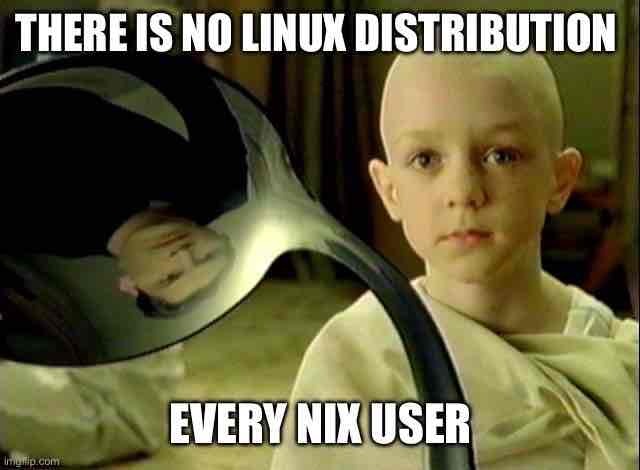When I read through the release announcements of most Linux distributions, the updates seem repetitive and uninspired—typically featuring little more than a newer kernel, a desktop environment upgrade, and the latest versions of popular applications (which have nothing to do with the distro itself). It feels like there’s a shortage of meaningful innovation, to the point that they tout updates to Firefox or LibreOffice as if they were significant contributions from the distribution itself.
It raises the question: are these distributions doing anything beyond repackaging the latest software? Are they adding any genuinely useful features or applications that differentiate them from one another? And more importantly, should they be?
the deployed architecture of linux is still evolving right now and there are lots of distros experimenting with different approaches
- how the basic core OS is structured - immutability, A/B partitions, versioned rollback
- how third party applications are executed - containerization, compatibilty, virtualization, bare metal
- how software is updated and stored - package management (apt, pacman, nix, flatpak)
i’m sure i’ve missed other features of new linux distros. this is all really important stuff but has nothing to do with the apps you actually use day to day
For me distro’s role is to repackage things and then test them to check if they work together. Kinda like a premade sandwitch.
Yeah, I’d rather the distro be as boring as possible while the exciting stuff happens upstream.
A boring release is the best kind of release. It means that most of the effort went into stability, compatibility, and bugfixes.
If you want updates to be exciting, install Arch, but only update it once every six months. You can even run bets on which system inroduces some breaking change that forces you to reach into its guts.
Since I started using the Nix package manager and switched to NixOS, the notion of a “Linux distribution” faded into little more than “A bootloader + the Linux kernel + some userspace programs”.

The same happens with any of the new immutable distributions. It’s just less effort as you do not need to do the nix configuration dance anymore.
You seem to be comparing a distro release to a new game release. It’s not. A distro is not always exciting because their top priority is having a working system. This means dealing with all the boring stuff.
It feels like there’s a shortage of meaningful innovation
You can look at this in another way: Linux distros are getting mature
are these distributions doing anything beyond repackaging the latest software?
You’re saying it like packaging the latest software is a trivial task.
typically featuring little more than a newer kernel, a desktop environment upgrade, and the latest versions of popular applications
If you don’t think these are meaningful to you, I don’t know what is.
Try phoronix.com if you want a more cutting edge reporting. They’re quite opinionated, but they’re usually on point about the exciting stuff.
Linux distros are getting mature
I think this is exactly it. Back in the early days of Fedora and Ubuntu a new release often meant major bug fixes, new software, and possibly a significant qol/usability changes and performance changes. Now, its all new versions of stable software, which all behave roughly the same. Which is exactly what you want in a daily driver OS. Stability.
comparing a distro release to a new game release
- pay a LinuxGem each time you open a terminal
- Flatpak is only available as a paid DLC
- use your LinuxGems to purchase randomized LootContainers with a chance of winning a Jellyfin install
The role of a distribution is to curate packages - select the right combination of versions and verify if it works together. Providing package repositories is also a big one, imagine if you had to compile everything on your machine yourself on every update (khm gentoo khm).
Other than that there isn’t really a lot of space for innovation. After you have a kernel, some base packages, package manager, and maybe a DE, you can install everything else yourself.
The main point of differentiation these days in on the package management side - do you want a rolling release, or a more conservative approach.There is one point of innovation left, but it highly technical and somewhat risky for everyday users -
libcalternatives. The C standard library is one of the few core packages in a distro that can’t really be replaced by the user.There is one point of innovation left, but it highly technical and somewhat risky for everyday users - libc alternatives. The C standard library is one of the few core packages in a distro that can’t really be replaced by the user.
Why would that be innovation? libc is stable and ubiquitous. Ironically, Gentoo would probably pull it off but it’s not for the distros to do, but rather upstream.
Alpine for example uses musl, and Gentoo offers it as an option.
I don’t completely understand the benefits, my own programming experience is several layers away from inner workings of an OS, but at least some distros claim there is space for improvement.This compares GNU’s libc with musl (aims at POSIX conformance and being lightweigth), uClibc (size) and dietlibc (size but has no full support?).
It leaves out Google’s bionic, used in Android, which is not compatible with GNU’s libc… go figure…
So most alternatives aim to be smaller and some also focus on standards compliance (GNU’s libc is not fully POSIX-compliant AFAIK).
they shouldn’t. everything should be rolling.
Server admins across the world now consider you a threat.
sudo deluser lurch sudosundray is not in the sudoers file. this incident will be reported.
Dang it!
This reminds me of Rob Pikes paper from the year 2000.
http://doc.cat-v.org/bell_labs/utah2000/utah2000.htmlHey, if you don’t think distributions are doing anything, you can always use Linux From Scratch.
Seriously though, most of the work done by good distros is specifically so you don’t notice things. They make a bajillion independent open source projects work together nicely. That’s something I’m glad I don’t have to do myself.
As someone who recently switched to Arch (btw) I finally figured out how much work the distros were doing in the background. Between default applications and configurations, there was a lot of stuff I had to learn to do on the fly. I’m happy with my system now though, since it’s just the way I wanted it to be.
I mean that is kinda the point of a distro. If they’re good the work gets merged upstream and benefits everyone. They collate and bug test and conflict resolve (It’s more involved than that, but for the sake of simplicity)
Honestly, when you say
are these distributions doing anything beyond repackaging the latest software?
— I have to wonder what you think is so trivial about keeping your system current with latest bug fixes and security updates?
I don’t need or want a distro to radically reinvent itself with every release. I had enough of that fuckery with Windows, way back when — incidentally, also a direct reason I quit that OS. And seeing “big changes” like Ubuntu deciding to functionally deprecate deb packages is… unappealing to me as well.
There are probably sexier updates going on in DEs, but (insofar as a distro isn’t wedded to one particular desktop environment) I’m fine to let them hog that glamour.
I guess if you want exciting new features you can just switch to a different distro nowadays or add them yourself. Why should distros add more stuff making them bloated or change stuff turning users away that like how things are currently? For general use you really don’t need a lot of fancy new stuff.
Some of them add bugs disguised as features, like Ubuntu’s snap
Funny, exactly what I mentioned in another thread https://lemmy.ml/post/21238446/14210360
Yes Snap is the bane of my existence. I actually had to create an ansible playbook for work that permanently removes the snap version of Firefox and then installs the official apt from Mozilla’s PPA. And on top I install other things my teams needs like VSCode and Chromium without using snaps. A nice repeatable process I wish I didn’t have to create but when certain clients insist on Ubuntu there is not much else to do
Since adopting a Flatpak and containerized workflow, the choice of distribution matters a lot less to me now than it did 10 years ago.
The majority of apps that I use everyday can be run from any host. And I can install fedora, arch, debian, or whatever I want as a container, whenever I want it, without any thought to my host system.
Ideally, Flatpak’s UX will continue to improve, and upstream app devs will continue to adopt it as an official support channel, which will improve overall security and confidence of the platform. Image-based, atomic distros will be further streamlined, allowing for even more easily interchangeable host images. At that point, traditional distros will be little more than an opinionated collection of command line tools and programming environments.
a shortage of meaningful innovation
Well… a distribution IS a selection of packages and a way to keep them working together. Arguably the “only” innovation in that context is HOW to do that and WHICH packages to rely on. For the first, the “latest” real change could be considered immutable distributions, as on the SteamDeck, and declarative setup, e.g. NixOS. For the second… well I don’t actually know if anybody is doing that, maybe things like PrimTux for kids at schools in France?
Anyway, I agree but I think it’s tricky to be innovative there so let me flip the question, what would YOU expect from an innovative distribution?
Well I’d like to see distros doing things to improve UX (which they now seem to have completely left to DEs). For example I remember when Ubuntu released their Hardware Drivers tool. It was samall but a super useful addition that made life easier for millions of users. But nowadays I see less app/utility contributions by distros.
Just yesterday I pinned VLC on my KDE Plasma Task Manager. Why? Because this way I can directly open “Recent Files” from it. I discovered about this functionality just last week with Libre Office Draw. It’s so efficient, it absolutely changed how I use my computer daily!
but… why do I bother with this long example? Because IMHO that’s from KDE, not Debian. When a distro improve the UX, as I also wish, it can be mostly by selecting the best software in its packages to maintain (e.g. here KDE but yes could indeed be their own custom made package, even though it requires a lot more resource AND other distro could also use them back assuming it’s FLOSS) but arguably the UX is mostly of the distribution itself is limited to the installation process.
What you’re asking for is distributions to roll their own solutions instead of contributing upstream to make it better for everyone. Distributions and the organizations behind them frequently do things to make the user experience better, it’s just that the preferred way to do this is by making the projects they use better…which will just look like a DE version bump by the time it makes it to a distro changelog.











